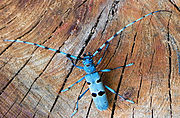The Rosalia alpina is one of the most beautiful and famous beetles in Europe, known for its characteristic black and blue coloration and the black tufts on the segments of its long antennae. With a body length that can reach up to 40 millimeters, it is one of the largest and most impressive beetles on the continent.
This species, which gets its name “alpina” due to its main distribution in the Alps, has great ecological importance. However, intensive use of beech forests for firewood and furniture production, coupled with forest management practices that involve the indiscriminate removal of deadwood, have seriously damaged its natural habitat. These changes have pushed the Rosalia alpina to the brink of extinction, drastically reducing the resources it relies on for feeding and reproduction.
Despite this, some specimens of the Rosalia alpina are still present in the Faggeta within the Pietraporciana Nature Reserve, which has become a vital refuge for biodiversity. This protected environment serves as a testament to the rich natural heritage of the area, comparable to that of other places with different altitudes and latitudes.
The presence of this beetle in such a biodiversity-rich reserve highlights the importance of intact natural habitats for the survival of endangered species. The Rosalia alpina, a symbol of nature in peril, serves as a reminder of the need to protect our mountain ecosystems to preserve Europe’s biological heritage.



